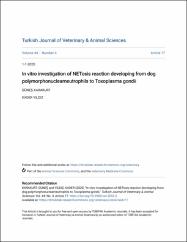| dc.contributor.author | Karakurt, Gunes | |
| dc.contributor.author | Yildiz, Kader | |
| dc.date.accessioned | 2021-01-14T18:10:59Z | |
| dc.date.available | 2021-01-14T18:10:59Z | |
| dc.date.issued | 2020 | |
| dc.identifier.citation | Karakurt, G., & Yıldız, K. (2020). In vitro Investigation of NETosis Reaction Developing from Dog Polymorphonuclear Neutrophils to Toxoplasma gondii. Turkish Journal of Veterinary and Animal Sciences, 44, 886–893. | en_US |
| dc.identifier.issn | 1300-0128 | |
| dc.identifier.uri | https://doi.org/10.3906/vet-2002-6 | |
| dc.identifier.uri | https://hdl.handle.net/20.500.12587/12848 | |
| dc.description | WOS:000560988800016 | en_US |
| dc.description.abstract | Toxoplasma gondii is known to develop extracellular traps from neutrophils in some animal species such as mice, cattle, sheep, cats, and donkeys. This study aimed to investigate the extracellular trap structures formed in dog polymorphonuclear leukocytes (PMNs) to T. gondii tachyzoites in vitro. Dog PMN was isolated using Percoll dilutions (45%, 54%, 63%, and 72%). After incubation with tachyzoites, the extracellular traps originating from the dog PMNs were observed in the extracellular areas. Histones (H3), myeloperoxidase (MPO), and neutrophil elastase (NE), the characteristic features of NETosis reaction, were detected in extracellular areas. The tachyzoites were observed between the extracellular trap structures. A positive correlation was detected between the parasite concentration and extracellular traps formation but they were not statistically significant (P > 0.05). Time-dependent relationships were also not statistically significant (P > 0.05). The extracellular traps released in the PMN-tachyzoite culture increased until the 60th min of incubation. Reactive oxygen species, MPO, and NE activities were observed in the PMN-tachyzoite culture during the incubation period. The development of extracellular traps against T. gondii in dog PMNs is reported for the first time in this study. However, it could not be determined whether the extracellular traps released from dog PMNs only mechanically immobilize or have some lethal effect on tachyzoites. | en_US |
| dc.description.sponsorship | Scientific Research Unit of Kirikkale UniversityKirikkale University [2017/80] | en_US |
| dc.description.sponsorship | This study was financially supported by the Scientific Research Unit of Kirikkale University (grant no: 2017/80) as a part of Gunes Karakurt's Ph.D. thesis. We would like to thank Dr. Cahit Babur for the T. gondii tachyzoites. | en_US |
| dc.language.iso | eng | en_US |
| dc.publisher | SCIENTIFIC TECHNICAL RESEARCH COUNCIL TURKEY-TUBITAK | en_US |
| dc.relation.isversionof | 10.3906/vet-2002-6 | en_US |
| dc.rights | info:eu-repo/semantics/openAccess | en_US |
| dc.subject | In vitro | en_US |
| dc.subject | dog | en_US |
| dc.subject | NETosis | en_US |
| dc.subject | polymorphonuclear leukocyte | en_US |
| dc.subject | Toxoplasma gondii | en_US |
| dc.title | In vitro investigation of NETosis reaction developing from dog polymorphonuclear neutrophils to Toxoplasma gondii | en_US |
| dc.type | article | en_US |
| dc.contributor.department | KKÜ | en_US |
| dc.identifier.volume | 44 | en_US |
| dc.identifier.issue | 4 | en_US |
| dc.identifier.startpage | 886 | en_US |
| dc.identifier.endpage | 893 | en_US |
| dc.relation.journal | TURKISH JOURNAL OF VETERINARY & ANIMAL SCIENCES | en_US |
| dc.relation.publicationcategory | Makale - Uluslararası Hakemli Dergi - Kurum Öğretim Elemanı | en_US |
















